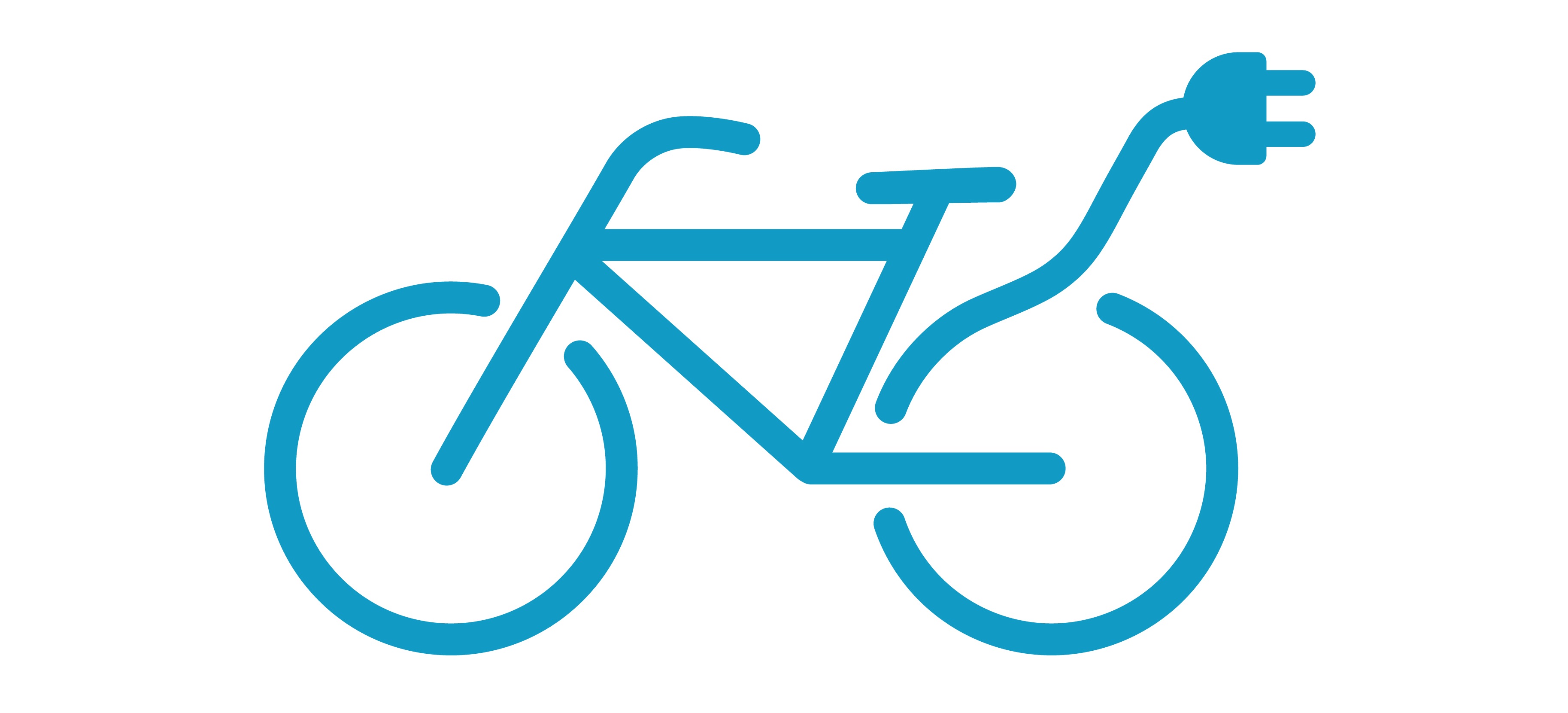Pete Prebus, the founder of Electric Bike Report, has made this excellent comparison.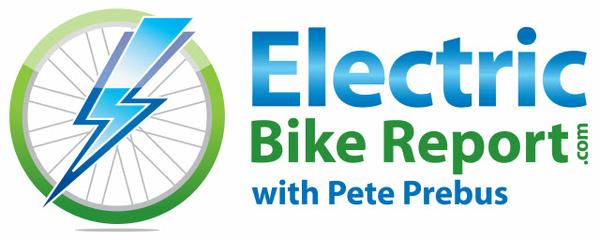
Hub Motors
Hub motors are electric motors that are housed inside the hub of either the front or rear wheel.
These are the most common motor that you will find on an electric bike (although mid drives are becoming very popular in certain markets).
There are direct drive hub motors that use the whole hub shell as the electric motor. And there are geared hub motors that have a smaller internal motor with planetary gears that drive the hub shell. Here is a comparison of direct drive and geared hub motors.
In addition, there is an emerging number of all-in-one hub or wheel systems that house all of the e-bike components (motor, battery, controller) in the hub or wheel.
Here is an overview of front hub, rear hub, and all-in-one hub motors with their pros & cons.
Front Hub Motors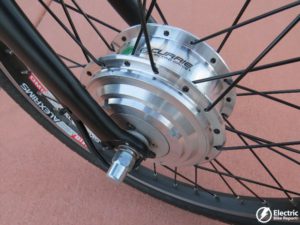
In general a front hub motor pulls you and it creates an all wheel drive e-bike.
PROS
- It creates an all wheel drive bike because the motor drives the front wheel and you can power the rear wheel with your pedal power. This can be advantageous for riding in snow or in sand. Some fat e-bikes are coming with front hub motors to create this all wheel drive system.
- Any type of bike drivetrain (gears) can be used: traditional gears with cogs, chain and derailleurs or internal geared hubs (IGH) with a chain or belt drive.
- Front hub motor systems are easy to install or remove from the bike because there are no gear systems to deal with (chain, derailleur, etc.) when compared to a rear hub motor. This is handy for fixing a flat tire or adding/removing electric assist from a conventional bike.
- Front hub motors can provide for a more balanced bike weight distribution if the battery is mounted in the middle or back part of the bike. This helps when lifting the bike onto a car rack or carrying the bike up stairs.
CONS
- Some riders do not like the feeling of being “pulled” by the motor.
- Since there is much less weight over the front wheel there is a tendency for the wheel to spin when accelerating on roads that have a layer of loose material (dirt, sand, snow, etc.) or when climbing a steep hill. This is more noticeable on the powerful and torquey front hub motors. I have found that after some time spent riding a front hub motor, you get used to this characteristic and adjust the assist and/or place more weight over the front wheel to work with these conditions.
- Front hub motors generally have a throttle and/or a cadence sensor pedal assist. It is rare to find a torque sensor based pedal assist system for a front hub motor.
- The front hub motors generally are focused on the lower power range (250 watts to 350 watts). There are higher powered front hub motors but they are not as common because the front fork of the bike does not provide as much of structural platform when compared the frame of the bike (rear hub motors).
- Front hub motors generally need a sturdy fork, especially for the higher powered motors. This is very important if you are installing a front hub motor kit on a conventional bike. Check with the kit company for their recommendations on what is required for the front fork. If you are buying a complete e-bike with a front hub motor, then the company selling the complete e-bike has most likely done their homework and supplied an adequate front fork to handle the motor’s power.
- They have a tendency to “bog down” on long steep climbs. See mid drive motors for climbing long and steep hills.
- The higher torque hub motors (generally the more powerful) need larger spokes and sturdy rims.
Rear Hub Motors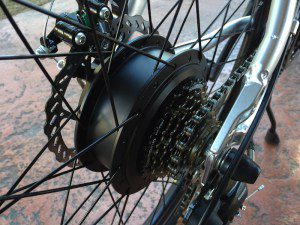
In general rear hub motors push you and they offer a wide range of power level options.
PROS
- Most people are familiar with the rear wheel driving the bike forward because that is the way 99.99% of bikes are built.
- There is significantly less tendency for the rear wheel to spin on loose road conditions because the majority of the riders weight is over the rear wheel.
- There is a wide range of power options (250 watts to 750 watts and beyond) because the bike’s frame provides a good structural platform to handle high torque from the motor.
- Rear hub motors can provide assist with a throttle and/or cadence or torque sensor pedal assist.
- Some direct drive rear hub motors provide regenerative braking.
CONS
- Rear hub motors are a little more cumbersome to install or remove because the gears (chain, derailleur, etc.) need to be worked around.
- They have a tendency to “bog down” on long steep climbs. See mid drive motors for climbing long and steep hills.
- Bikes that have a rear hub motor with a rear rack battery are back heavy and that can affect the handling of the bike. Some riders may not notice this if they are riding in a more cautious manner vs. a performance riding style. Back heavy e-bikes can be hard to handle while lifting onto a car rack or carrying the bike up stairs. Removing the battery can help with this.
- The higher torque hub motors (generally the more powerful) need larger spokes and sturdy rims.
All-In-One Wheel Motors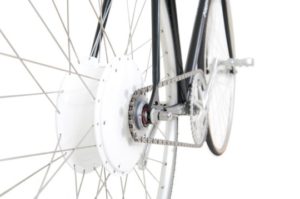
The all-in-one electric bike wheels house everything in the hub or wheel; motor, battery, controller, etc.
These systems come in either the front or rear wheel configuration and in general the pros and cons (see above) for each configuration apply. Here are some pros and cons for the all-in-one systems.
PROS
- In general they are touted as being easy to install or remove because it involves the replacement of either the front or rear wheel along with installation of a few other components.
- They keep the looks of the bike pretty clean. Some people may not recognize that it is an electric bike.
- Some of these systems have smartphone integration that provide a wide array of features: adjusting the settings, tracking rides, locking the wheel, etc.
CONS
- Repairing and/or replacing components of the system may be more difficult when compared to traditional electric bike kits. The wheel may need to be sent back to the company for service.
- Some all-in-one systems have just one size of battery pack. Some traditional electric bike kits have the option to increase the battery size for more range.
- Housing the battery so close to the motor can expose the battery to excess heat that can affect its range and lifespan. Some all-in-one systems may have a design that minimizes this issue but that will need to be evaluated on a system by system basis.
Mid Drive Motors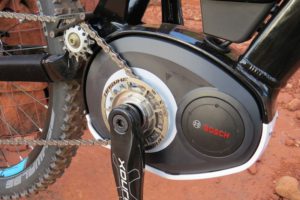
In general a mid drive motor powers through the drivetrain (transmission) of the bike which enables the motor to help with long & steep climbs and power up to high speeds on flat roads.
PROS
- Mid drive systems are known for being able to climb long steep hills because they can leverage the lower gears of the bike and keep their rpm’s in an efficient range without getting “bogged down” like a hub motor. This is a good feature if you ride in areas that have consistently long and steep climbs.
- These motors can also leverage the higher gears of the drivetrain to cruise along at high speeds on the flat or inclined roads.
- Since the motor is at the cranks of the bike it provides for a low and centered weight distribution. If the battery is mounted in the center of the bike that further adds to great weight distribution which is good for the handling of the bike as well as making it easier to lift onto a car rack or carry up stairs.
- Removing the front or rear wheel is easy because there are no motor wires or hardware to remove (compared to hub motors). The bike can use almost any wheel type along with quick releases front and rear.
- Most mid drive systems use a chain, cogs, and derailleur drivetrain. Some systems are compatible with internally geared hubs and belt drives. The E2 Drives combines the mid drive motor with a “gearbox” at the cranks.
- There is the ability for a mid drive system to use a throttle and/or cadence or torque sensor pedal assist. Some mid drives are pretty sophisticated with sensors that measure the pedal power, wheels speed, and crank speed to provide assist that blends with the riders power to create a very intuitive ride feel. There are also sensors that will reduce power when the system senses that the rider is going to shift gears to make the shift smoother. In addition there are some mid drives that are integrating with electronic shifting systems.
CONS
- Since the power is being transferred through the drivetrain of the bike there can be more wear applied to the drivetrain components (chain, cogs, derailleur, etc.). The higher power systems will add significantly more wear and those components may need to be replaced on a more frequent basis.
- To keep the mid drive motor operating efficiently you need to be shifting the gears properly for climbing hills or cruising along the flats. If you are used to shifting the gears properly on a conventional bike then this is nothing new.
- Some mid drive systems can sense when you are going to shift the gears and they will reduce the power for a smoother shift. There are some systems that don’t have these sensors and that can lead to abrupt shifts when the motor is applying full power.
- A majority of mid drives have a single chainring which limits the gear range to a rear cogset or to the gear range of an internally geared hub. For most riding conditions this is okay because the motor makes up for the gear range that is missing and the gear range of a rear cogset or IGH is pretty wide these days.
- Most of the popular mid drives systems are only available on complete e-bikes with specific frame mounts. There are not many retro-fit mid drive kits to choose from right now but it seems that there may be more on the horizon.
Friction Drive Motors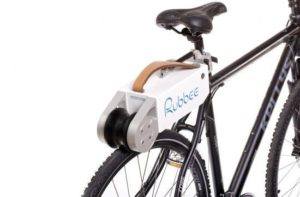
In general these motors have a roller that sits on the bike wheel and uses friction to transfer the power from the roller wheel to the bike wheel.
PROS
- A friction drive kit can work on a wide range of conventional bikes and some kits offer quick installation or removal.
- These tend to be relatively simple systems that may have the advantage of less things to go wrong.
CONS
- Friction drive systems don’t work well in wet weather because the friction element diminishes.
- Most systems don’t work well with really knobby off road tires.
- Some of the friction drives are not as aesthetically “clean” when compared to other systems.
Check out the comments to this article on ElectricBikeReport.com
